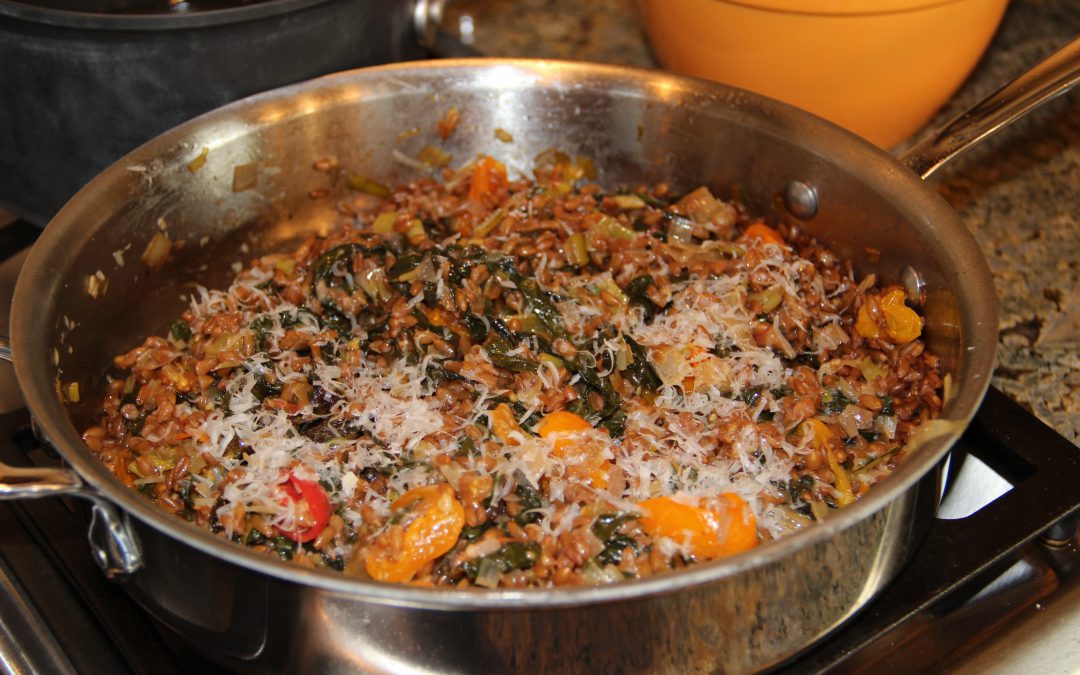[vc_row][vc_column width=”1/1″][vc_column_text]
Farro has become a trendy grain, but it is actually one of the oldest grains we know. Farro is related to wheat, and it’s origins are most likely in Italy. It is remarkably tasty with a nutty flavor and a chewy satisfying bite, and has more fiber than many other whole grains.
The actual definition of farro is a bit confusing, since it can be called spelt, emmer, or einkorn. Most of the farro we get in the US is emmer imported from Italy, grown in the mountain regions of Tuscany and Abruzzo. We’ve seen many farro recipes, using the grain in soups, salads, or as a rice substitute.
In this article, we continue our series on how to adapt the risotto technique to other grains. Farro was a bit of a challenge, and there were quite a few batches before we got the taste and texture that reflected the classic risotto style. If you find the whole grain variety, it is essential that you soak the grain overnight. However, most of the versions you’ll find are the semi-pearled variety, which means it retains some, but not all of its bran and nutrients. If you are not sure (sometimes the labels are not clear), then you should soak it.
[/vc_column_text][/vc_column][/vc_row][vc_row][vc_column width=”1/1″][vc_separator color=”grey”][/vc_column][/vc_row][vc_row][vc_column width=”1/1″][vc_column_text]
- 2 cups farro
- 12 cups (3 quarts) stock (vegetable or chicken stock), plus 4 cups water
- 1 bay leaf
- 3 tablespoons extra-virgin olive oil
- 4 tablespoons butter
- 1 ½ cups pinot noir
- 2 leeks, thoroughly washed, julienned
- 2 bunches of Swiss chard, thoroughly washed, chiffonade (you can substitute spinach)
- 1 cup freshly grated Parmesan
- 12-15 small yellow tomatoes, quartered and lightly roasted.
- 2 tablespoons chopped fresh parsley
- Freshly ground black pepper, to taste
- Rinse the farro in cold water, and let drain.
- Heat 4 cups of stock and 2 cups of water in a medium sauce pan, plus ½ teaspoon salt. When the stock is boiling, add the farro. Reduce to simmer, and cover. Cook until the liquid is absorbed (about 20 minutes).
- Heat the remaining broth and water with the bay leaf, and keep to a simmer.
- In a large sauté pan, heat the olive oil and 2 tablespoons of butter over medium heat. Cook the leeks, stirring often, about 5 minutes. Add the Swiss chard, and cook for another 3 minutes.
- Add the par-cooked farro, and stir to coat with the oil. Toast the farro (don’t stir) until the edges become translucent, about 2 minutes.
- Pour in the wine and stir well until evaporated. Add 2 cups of the hot broth and ½ teaspoon salt. Cook, stirring constantly, until all of the broth has been absorbed, about 5 minutes. Add the remaining broth, about ½ cup at a time, allowing the liquid to be absorbed before adding more. Keep stirring and adding broth until the farro is tender and mildly creamy. This last step will take about 20 minutes. Reduce the heat to low.
- Add the butter, stir until melted, then add the cheese. Adjust seasoning with salt and pepper, if needed. Sprinkle with chopped parsley before serving.
[/vc_column_text][/vc_column][/vc_row]



